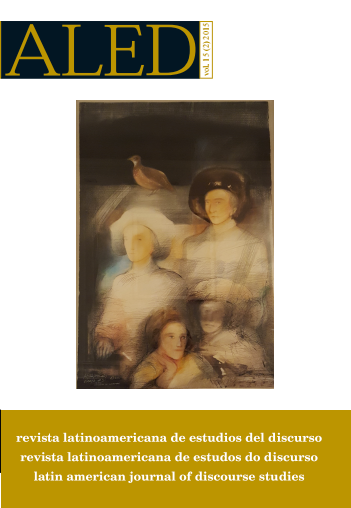Ni diálogo ni debate
la voz de la audiencia en los comentarios digitales sobre la pobreza
Keywords:
digital media. poverty. audience participation. reader comments.Abstract
The aim of this paper is to present the partial results of a research in progress that addresses how the Argentinian news media approaches the issue of poverty. In this particular case, we analyze reader comments of news related to the relevant political and social issue of poverty. Our aim is to determine the ways in which the dialogue among the news piece, its readers and the medium in question is articulated, and how, even without being legitimized by the medium, it still forms part of the publication and is, therefore, public (Noblía, 2015). The theoretical framework is Critical Discourse Analysis (Fairclough 1995, 2003, 2006) and the methodology is qualitative. As for the linguistic analysis, this research adopts the synchronic-diachronic method to the linguistic textual analysis (Pardo 2011, 2014). The corpus consists of forty news pieces, compiled between July 2014 and June 2015 from La Nación.com.
Downloads
References
Carrizo, A. en prensa. Disparen contra el pianista: construcción social de la figura denigrada. Actas del Coloquio Internacional “Violencia en América Latina”
Discursos, Prácticas, Actores. Buenos Aires: Observatorio interdisciplinario sobre discursos de la violencia estatal en América Latina.
Dery, M. 1993. Flame wars: The discourse of cyberculture. Durham, NC: Duke University Press.
Fairclough, N. 1995. Critical discourse analysis: The critical study of language. London: Longman.
Fairclough, N. 2003. Analysing discourse: Textual analysis for social research. London: Routledge.
Fairclough, N. 2006. Language and globalization. London: Routledge.
Habermas, J. 1986. La teoría de la acción comunicativa. Madrid: Taurus.
Ma, R. 1996. Computer-mediated conversations as a new dimension of intercultural communication between East Asian and North American college students. En S. Herring, (ed.). Computer mediated communication. Linguistic, social and cross-cultural perspectives, pp. 173-186. Amsterdam/Philadelphia: John Benjamins Publishing Company.
Mancera Rueda, A. en prensa. “El problema es que siempre hay un politicucho que no tiene ni p*** idea de nada y nos la lía”: (des)cortesía y actividades de imagen en las manifestaciones de la opinión de los lectores de la prensa española. Revista del Instituto de Investigaciones Lingüísticas y Literarias Hispanoamericana, 19, I.
Martin, J. y White, P. 2005. The language of evaluation. Appraisal in English. London: Routledge.
Noblía, M. V. 2000a. Conversación y comunidad: Las chats en la comunidad virtual. Revista Iberoamericana de Discurso y Sociedad 5, 2: 77-99.
Noblía, M. V. 2000b. Internet, comunidad virtual y control, En M. V. Noblía y M. L. Pardo (eds.). Globalización e internet: impactos multidisciplinarios, pp.53-78. Buenos Aires: Biblos.
Noblía, M. V. 2008. [Disponible en http://www.edice.org/programa/]. La construcción de la identidad en las chats. D. Bravo y A. Briz (ed.). Actas del III Coloquio Internacional del Programa EDICE. Cortesía y conversación: de lo escrito a lo oral, pp.503-537. Valencia: Universidad de Valencia . [Acceso: 3 de septiembre de 2015].
Noblía, M. V. 2014. Modes, medium and hypertext: some theoretical and methodological issues in the conceptualization of genre in digital texts. En S. Alsopy y S. Gardner (eds.). Language in a digital age: be not afraid of digitality, Proceedings from the 24th European Systemic functional linguistics conference and workshop, pp. 122-123. Coventry: Coventry University.
Noblía, M. V. 2015. Un pacto de mutua agresión: la negociación de la imagen y el rol de la audiencia en los diarios digitales. Los comentarios en el diario La Nación. Textos en Proceso 1: 17 51.
Pardo, M. L. y Noblía, M. V. en prensa. El discurso sobre la criminalidad en YouTube. Juventud y estigma. En G.a Muniz y R. Limberti (eds). Discurso e (des)igualdade social - vol. 2. San Pablo: Editora Contexto.
Pano, A. 2012. Diálogo e información conversacional en la prensa digital española. En A. Cassol, F. Gherardi, A. Guarino, G. Mapelli, F. Matte Bon y P. Taravacci (eds.). Il dialogo. Lingue, letterature, linguaggi, culture. Atti del XXV Convegno AISPI (Napoli, 18-21 febbraio 2009), pp. 351-358. Roma: AISPI Edizioni.
Pardo, M.L. 1996. Derecho y lingüística. Cómo se juzga con palabras. Buenos Aires: Nueva Visión.
Pardo, M.L. 2011. Teoría y metodología de la investigación lingüística. Método sincrónico-diacrónico de análisis lingüístico de textos. Buenos Aires: Tersites.
Pardo, M.L. 2014. O método sincrônico-diacrônico de análise linguística de textos. En M. Santos, C. Cataldi y M.C. Aires Gomes (orgs.). Estudios discursivos en foco. Novas perspectivas, pp. 159-185. Viçosa, Brasil: Editora UFV.
Pardo, M.L. 2015. [Disponible en: http://periodicos.unb.br/index.php/les/issue/ current/ showToc]. La categoría de lugar: de la gramática al discurso. Cadernosde Linguagem e Sociedade 16, 1: 36-47 [Acceso: 10 de septiembre del 2015]
Qian, H. y Scott, C. 2007. Anonymity and self-disclosure on Weblogs. Journal of Computer-Mediated Communication 12: 1428-1451.
Rheingold, H. 1993. The virtual community. Homesteading on the electronic frontier. London: Addison-Wesley Publishing Company.
Selfe, C., y Meyer, P. R. 1991. Testing claims for on-line conferences. Written Communication 8, 2: 163-192.
Strauss, A. y J. Corbin. 2002. Bases de la investigación cualitativa. Técnicas y procedimientos para desarrollar teoría fundamentada. Antioquia: Editorial Universidad de Antioquia.
Tsikerdekis, M. 2012. The choice of complete anonymity versus pseudonymity for aggression online. eMinds: International Journal on human-computer interaction 2, 8: 36 57.
Downloads
Published
How to Cite
Issue
Section
License

This work is licensed under a Creative Commons Attribution-NonCommercial-NoDerivatives 4.0 International License.
The authors retain the copyright and guarantee RALED the right to be the first publication of the work as well as a Creative Commons Attribution License that allows others to share the work with recognition of authorship and the initial publication in this journal.




